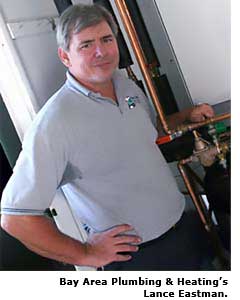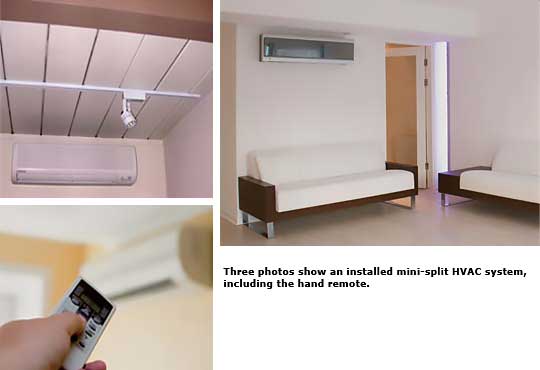Cool Current Today: Air Conditioning and Back-Up Heating - Page 2
The SpacePak system uses sound attenuators, or short lengths of flexible, baffled tubing to help keep the system quiet. A plenum carries cool or warm air from the fan coil unit to the different ducts throughout the house. The fan coil connects to an external condenser for cooling. SpacePak also offers an optional PurePak air cleaner that captures contaminants from the air as mall as 0.3 microns with 97 percent effectiveness, the company reports.
Indoors, the vent grills are five inches in diameter (roughly the size of a compact disc) and homeowners can choose from cast iron, wood, plastic, or brass finishes. "It looks good, but it's a big project that takes two to three weeks with a new foam roof," Bock says.
Mini-Splits
Ductless mini-split systems are a practical and cost-effective retrofit cooling and heating option. Like conventional central air conditioners, mini-splits use an outside compressor/condenser (roughly 20 by 30 by 10 inches). The difference is that every room or zone to be cooled has its own interior air handler that is roughly 10 by 33 by seven inches in size.

"Each indoor unit operates independent of the other, which makes it easy to control the temperature in specific rooms and further save energy consumption," points out Lance Eastman, owner of Bay Area Plumbing & Heating, based in Redwood City.
The interior units connect to the outdoor unit through a conduit carrying the power, refrigerant, and condensate lines. The air handlers come in various sizes to cool areas up to 1,000 square feet. "The advantage of this set-up is that the conduit is no more than three inches in diameter, making it possible to install these systems in a more unobtrusive way," Eastman explains.
From the outside, the unit can be tucked along of the house or in an area of the yard where it's not noticeable. The conduit can be installed through the roof, or through exterior walls. The condensate can be drained to the outside, or as some homeowners have done, through the drain in the laundry room (for those who don't want to penetrate the roof).
Unlike window air-conditioning units, mini-splits keep a home more secure, since there are no large openings in walls or windows that invite intruders. They are also quiet. Air handlers fit snugly against the interior wall, and can be placed in between beams to be less noticeable. Some owners, says Eastman, have created cosmetic encasements to disguise the indoor units and blend them into their home's decor.
The condenser can also be located as far as 40 feet from the air-handling unit, making it easier to tuck it away on the side or back of the house. One condenser, depending on its capacity, can support as many as four air-handling units. By avoiding the use of ductwork, mini-splits also avoid energy losses associated with central forced-air systems. New mini-split systems for an average home cost around $5,000 apiece, Eastman says.
Mini-splits are manufactured by a host of companies, including Samsung, Mitsubishi, Fujitsu, Hitachi, and Friedrich. These companies have established good lines of distribution, training, and technical support.

Valance
William Lipp, owner of Lipp Hydronics in Redwood City, invented his own radiant-heat system, installed on ceilings and walls, in 1974. "At the time, the baseboard heating systems [once the only radiant-heat replacement option for Eichler homes] on the jobs I went on were all looking tattered, and it was not offering the best heating for Eichlers," Lipp says.

He created the Valance system: a long, thin unit, about nine inches deep, that runs hot water through fin tubes. Usually hung along the beams in an Eichler ceiling, the tubes are concealed using a five-inch face board or wooden grill. Air enters the heating unit from the bottom, and it is heated and distributed from the top. "There are no fans or blowers, so it's very quiet and efficient like any type of radiant heating," Lipp says.
If a homeowner hangs the Valance on the wall, Lipp points out, it can be painted or wallpapered to blend into the room's décor. Lipp usually recommends at least one Valance unit per room, and a whole-house install, he says, costs between $12,000 and $30,000 with a new high-efficiency boiler. There is no cooling option available with the Valance.
"This system really fits in Eichler homes," Lipp says. "Customers say that the Valance system offers more comfortable heat than traditional radiant."




